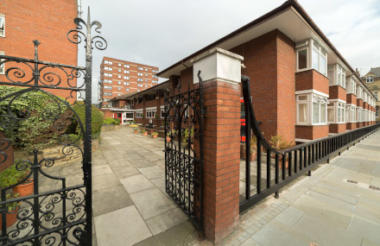Walk through the old market towns and villages of England and Wales and you will find a few houses of distinct character, often set back from the road, often in a courtyard. They have high chimneys and front doors that are close to each other. The detail of the architecture changes from county to county but the spirit of these homes is common.
They represent a village, town or patron that has at some point in the past stepped up and said “I will do something about a home for those in need!”
Almshouses have existed in the United Kingdom for over a thousand years, with the first thought to be the Hospital of St Oswald in Worcester, founded circa 990. Yet this model of housing is often seen as a quirky vestige of a bygone era. In reality they are a sign of social activism – established to see that those who are in housing need have a home that is warm and friendly, safe and secure, where they pay a weekly charge that does not further create hardship for the resident - the words used in nearly all almshouse governing documents.
In many rural areas the almshouse is the only form of affordable housing. Today, some 36,000 people find themselves living in an almshouse, often occupied by the elderly but increasingly becoming a provision for younger, more diverse, people and families in housing need. At their heart they are driven by compassion and actively encourage companionship. Across the country many of the 1,700 individual Almshouse charities are looking to expand.
Demand for community housing is growing
So why is this ancient housing model still relevant? We have housing associations, council and social housing? It is interesting to note that in pockets of villages and towns across the country, the demand for this form of small, intimate, community housing is growing.
There are between 500 – 700 new almshouse dwellings in the process of being built now and many more at the planning stage. The demand for almshouse accommodation outstrips supply in most areas.
It is not just the fact that they fill a gap in the housing need; they often seem to fill a vital gap the lives of the residents. Recent research recognised the value of almshouses in preventing isolation and loneliness with their communal courtyard gardens. They represent a form of genuinely affordable housing that includes neighbourliness as one of its priorities.
Unique, shared spaces
Almshouses are exempt from the Right to Buy scheme so they stay with the community – sometimes for centuries. They are run by trustees from the community and, as charities, the governing documents set out the terms of occupancy. New developments are designed to capture the characteristics that make them so unique, with shared spaces to meet, drink tea and chat. The modern almshouse is designed for privacy inside the home but opportunities to meet outside.
Many older almshouses are being re-developed or renovated with eco-friendly improvements to meet today’s quality standards but still retaining some features of their architectural history.
Others which have reached the end of their useful life, are being rebuilt for the 21st century. Southwark Charities’ Almshouses in London, for example, has advanced plans for a socially-responsible mixed scheme with 60 modern, purpose-built almshouses situated within affordable workspace and commercial outlets to support jobs and generate income in the area.
Lack of awareness
The affordable housing crisis is deeply embedded across the country and there are few opportunities for young or elderly to remain near their rural communities. Consequently, there is a growing feeling of reversing this trend and almshouses have a legal definition approved by the Charity Commission.
However, there are barriers preventing new almshouses being built and new charities starting. The main one is awareness. In a recent YouGov survey, 68 per cent of respondents had not heard of almshouses. Another issue is that they are misunderstood by local councils – and then, of course, they need funding.
This year The Almshouse Association awarded nearly £1.3m in loans and grants to member charities that were struggling - partly because it has been such a challenging year and partly because the demand for almshouses is increasing far beyond supply.
The almshouse model is that they are local charities based run by local trustees. They are a part of a very local and long term solution to the rural affordable housing crisis. They may only be one part of the solution to our affordability crisis, but they are a part which has endures and proven itself ready for the challenge of today.
With a greater awareness and appreciation of almshouses and the impact they have on the individuals they support, both within the sector and beyond, they can become a viable option for newcomers as well as a trusted part of our local communities.
The charity sector is crucial in filling a gap which government sadly neglects. We already have trustees and volunteers who give of their time – but we always need more and will always welcome partnerships and support.
Nick Phillips is CEO of The Almshouse Association - a support charity representing over 1,600 independent almshouse charities across the UK, which this year is celebrating its 75th anniversary
Related articles












